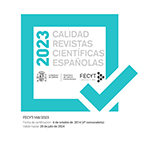¿Bebés o tejidos celulares? Individuación y parentesco del embrión criopreservado entre usuarios y actores de la fertilización in vitro en Ciudad de México
Resumen
Con base en un estudio etnográfico llevado a cabo en Ciudad de México con personal médico de clínicas de reproducción asistida, así como entre usuarios y usuarias de fertilización in vitro (FIV), este artículo explora el entramado de relaciones en que se ubican los embriones criopreservados y vitrificados. Postula que, al crear seres inclasificables desde el punto de vista de moral y legal, las biotecnologías perturban el equilibrio de categorías preexistentes y originan otras. Explica cómo el marco legal, religioso y político que impera en México durante el periodo 2015-2017 determina que, al producto de esta tecnología, se le pueda considerar "hijo", "bebé", "no nacido" o "concebido", entre otros apelativos. El óvulo fertilizado aparece, entonces, en el discurso y en el habla bajo términos de apelación que evocan aspectos subjetivos y relacionales. El destino final del embrión su conservación, donación a la investigación su conservación, donación a la investigación científica, adopción o desecho no solo depende de su científica, adopción o desechosu conservación, donación a la investigación científica, adopción o desecho no solo depende de su no solo depende de su reconocimiento bajo alguno de esos términos, sino que, tal como estudios realizados en Francia (Giraud, 2014) y Estados Unidos (Collard y Kashmeri, 2009; Cromer, 2018) plantean, otros parámetros intervienen, como la edad, el sexo, la situación financiera o de salud de los padres o propietarios. El presente estudio va más allá al sugerir que el lugar de los embriones en la genealogía tanto como la experiencia previa de los padres o propietarios en ciclos de FIV son factores definitorios en la personificación y en el establecimiento de lazos de parentesco.
Descargas
Descarga artículo
Licencia
La revista Política y Sociedad, para fomentar el intercambio global del conocimiento, facilita el acceso sin restricciones a sus contenidos desde el momento de su publicación en la presente edición electrónica, y por eso es una revista de acceso abierto. Los originales publicados en esta revista son propiedad de la Universidad Complutense de Madrid y es obligatorio citar su procedencia en cualquier reproducción total o parcial. Todos los contenidos se distribuyen bajo una licencia de uso y distribución Creative Commons Reconocimiento 4.0 (CC BY 4.0). Esta circunstancia ha de hacerse constar expresamente de esta forma cuando sea necesario. Puede consultar la versión informativa y el texto legal de la licencia.











